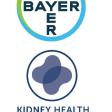
University of California, San Francisco (UCSF), Kidney Health Research Collaborative (KHRC), and San Francisco VA Health Care System (SFVAHCS) has released 2 real-world evidence studies that are focused on helping appropriate patients with chronic kidney disease (CKD) access more timely treatment.
More than 1 in 7 American adults (14%) are estimated to have CKD, with diabetes and high blood pressure being the most common causes of CKD in American adults.1 Many of these patients are unaware of their disease because there are typically no or few symptoms in the early stages of the disease and, historically, there is under-detection of CKD due to lack of testing. Treatment for CKD depends on the stage of disease and, while there is no cure, treatment can help slow its progression and lower the burden of associated heart disease complications.2
We are pleased to report the findings from collaborative studies with Bayer, who funded this work:
- Prescription Patterns of Cardiovascular- and Kidney-Protective Therapies Among Patients with Type 2 Diabetes and Chronic Kidney Disease was undertaken to assess the prevalence and correlations of prescriptions for 2 drugs that protect against CKD progression and heart disease events, sodium-glucose cotransporter 2 inhibitors (SGLT2is) and/or glucagon-like peptide 1 receptor agonists (GLP1-RAs) in individuals with T2D with and without CKD. This was a cross-sectional analysis of SGLT2i and GLP1-RA prescriptions from 1 January 2019 to 31 December 2020 in the Veterans Health Administration (VHA) System. This study, which was published in Diabetes Care, demonstrated that patients with the greatest risk of cardiovascular disease (CVD) and kidney failure (ie, with severe albuminuria, elevated 10-year risk of atherosclerotic CVD, and 5-year risk of end-stage kidney disease >5%) were less likely to receive SGLT2is or GLP1-RAs.3
- Estimated Prevalence and Testing for Albuminuria in US Adults at Risk for Chronic Kidney Disease aimed to estimate the extent of albuminuria under-detection from lack of testing and evaluate its association with provision of common CKD treatments in patients with hypertension or diabetes. Using data from the 2007 to 2018 National Health and Nutrition Examination Surveys (NHANES), a model was created to predict abnormal albuminuria levels based on multiple predictor variables; this model was then applied to a 5% random sample of the Optum de-identified electronic health record dataset from 1 January 2017 to 31 December 2018 to predict the likelihood of abnormal albuminuria in untested patients in the clinical dataset. The results of these analyses, recently published in JAMA Network Open, estimate that two-thirds of patients with albuminuria were undetected due to lack of testing and that albuminuria testing was associated with greater likelihood of receiving CKD treatments. With improved identification of albuminuria, there would be a substantial opportunity to optimize care delivery for reducing kidney disease progression and cardiovascular complications.4
References:
- Centers for Disease Control and Prevention. Chronic kidney disease in the United States, 2023. May 30, 2023. Accessed July 24, 2023. https://www.cdc.gov/kidneydisease/publications-resources/CKD-national-facts.html
- National Health Service. Chronic kidney disease – treatment. March 23, 2023. Accessed July 24, 2023. https://www.nhs.uk/conditions/kidney-disease/treatment/
- Lamprea-Montealegre JA, Madden E, Tummalapalli SL, et al. Prescription patterns of cardiovascular- and kidney-protective therapies among patients with type 2 diabetes and chronic kidney disease. Diabetes Care. 2022;45:2900-2906.
- Chu CD, Xia F, Yuxian D, et al. Estimated prevalence and testing for albuminuria in US adults at risk for chronic kidney disease. JAMA Network Open



